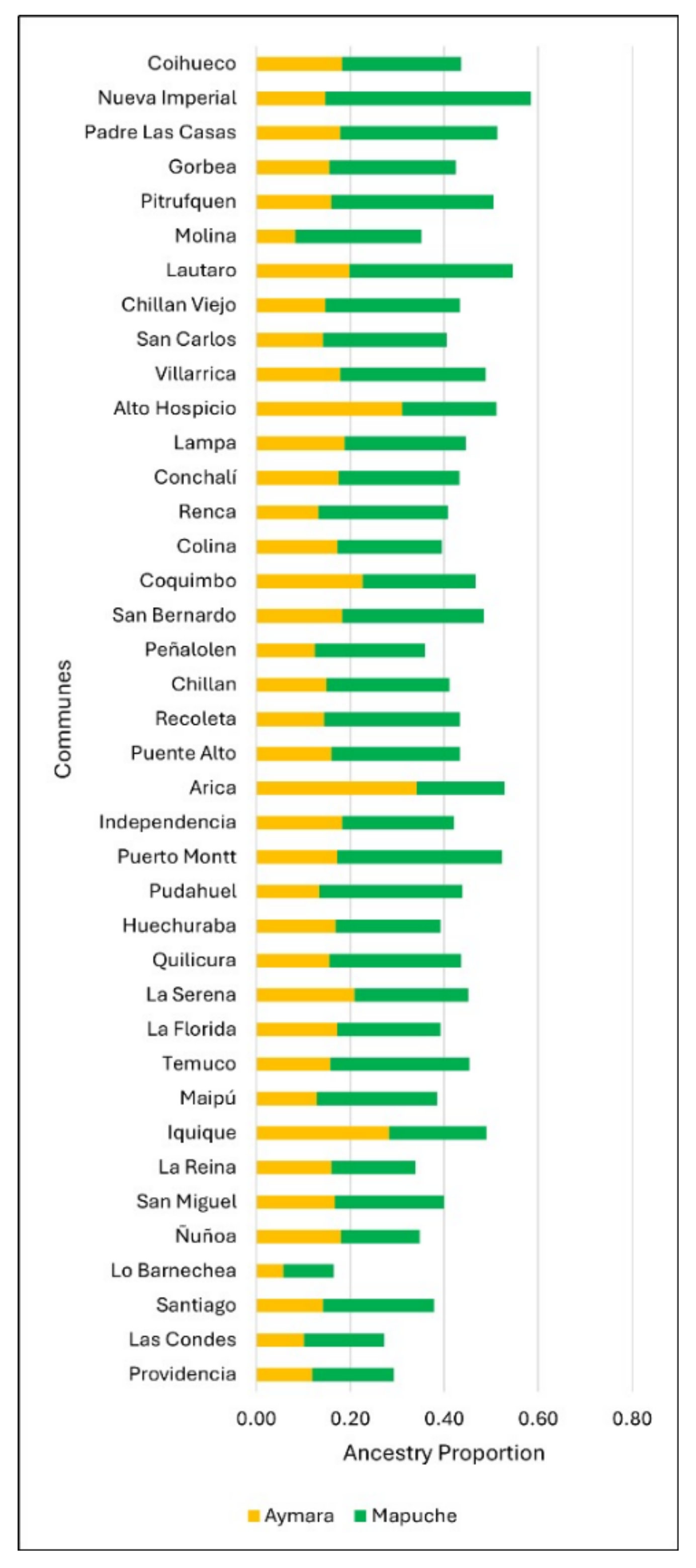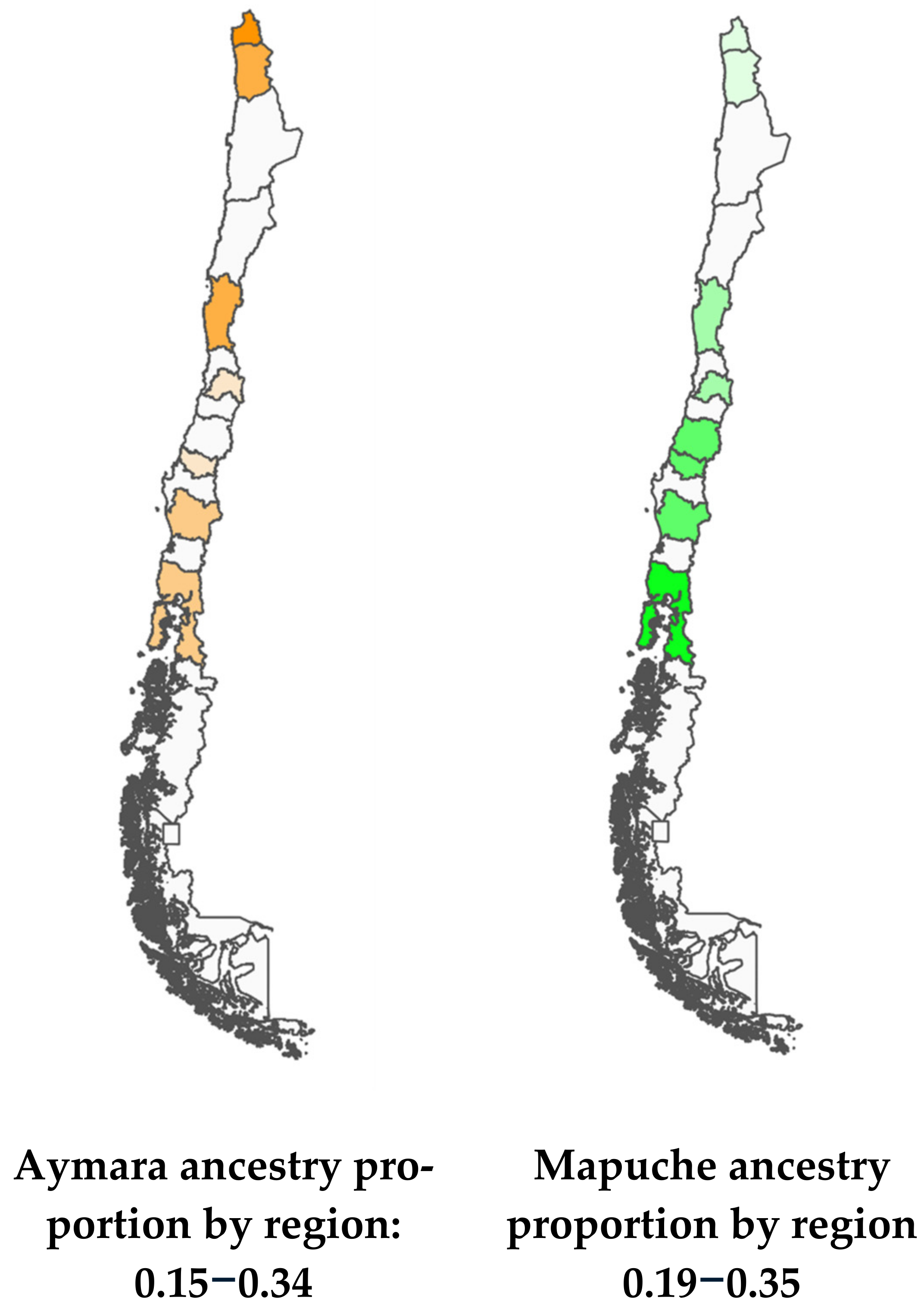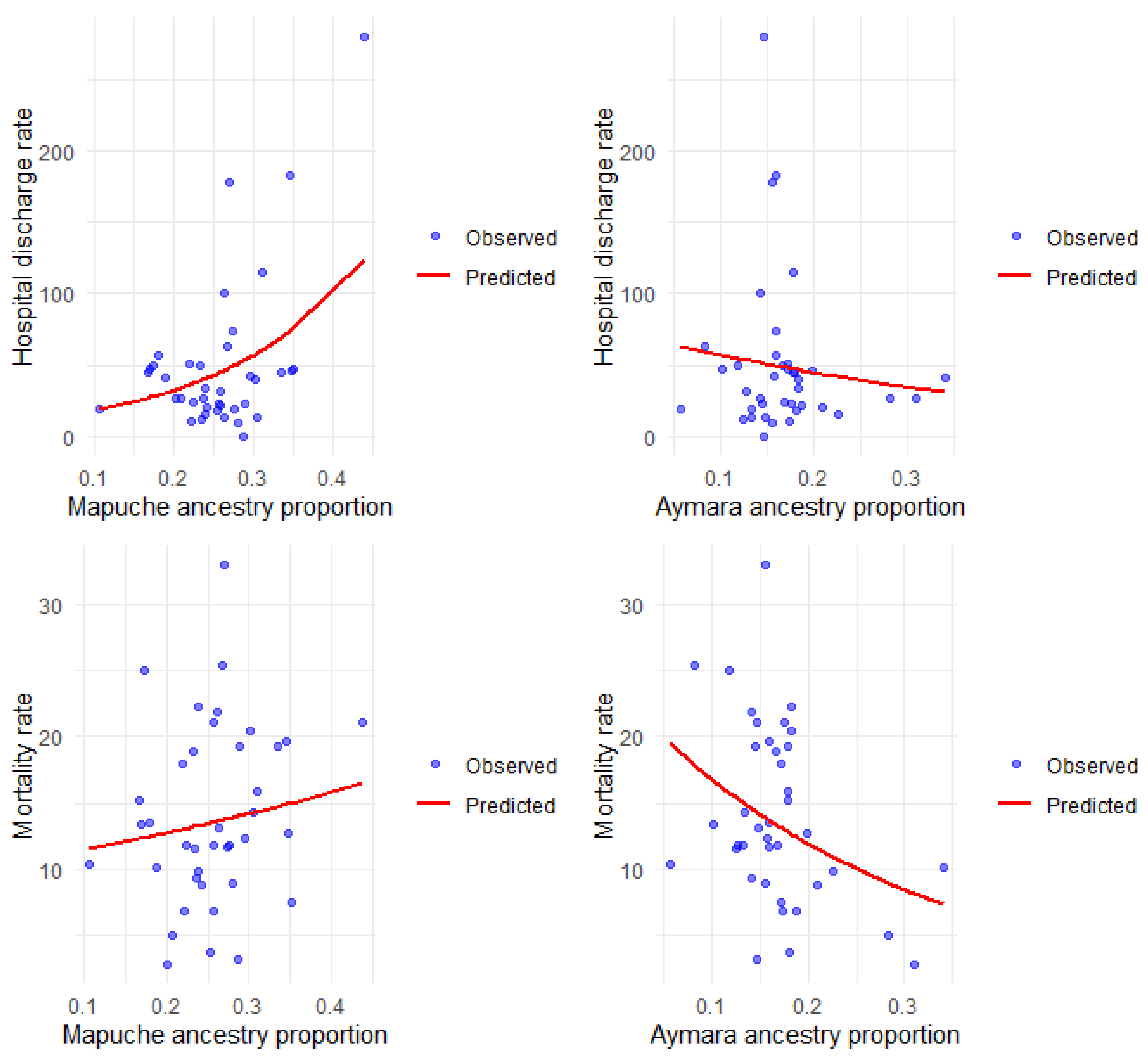Association Between Amerindian Ancestry and Chronic Obstructive Pulmonary Disease in the Chilean Mixed Population
Abstract
1. Introduction
2. Materials and Methods
- Communal Development Index (CDI): Calculated in 2020 by the Universidad Autónoma, it corresponds to the multidimensional evaluation of Chile’s communes in economic, educational, and health aspects, taking values ranging from 0 (minimum development) to 1 (maximum development) [42].
- Elderly People Proportion (EPP): Quotient between the number of people over 60 in a commune and the total population. We calculated it from the CENSUS 2017 database [38].
- Smoking rate of 100 or more cigarettes (SMK100): Estimates the proportion of people who have smoked 100 or more cigarettes in their lifetime. This variable was obtained from the National Health Survey (NHS) from years 2016–2017 [43]. We calculated the percentage of people in each commune who have smoked 100 cigarettes or more in their lifetime.
3. Results
4. Discussion
5. Conclusions
Author Contributions
Funding
Institutional Review Board Statement
Informed Consent Statement
Data Availability Statement
Acknowledgments
Conflicts of Interest
Abbreviations
| AIMs | Ancestry Informative Markers |
| COPD | Chronic Obstructive Pulmonary Disease |
| DEIS | Departamento de Estadísticas e Información en Salud |
| GWAS | Genome-Wide Association Studies |
| CDI | Communal Development Index |
| EPP | Elderly People Proportion |
| SMK100 | Proportion of people who have smoked 100 or more cigarettes |
| r | Pearson correlation coefficient |
| IRR | Incidence rate ratio |
| HD | Hospital discharge ratio |
| SMR | Specific mortality ratio |
Appendix A
| Commune | %AYM | %MAP | EPP | CDI | SMK100 |
|---|---|---|---|---|---|
| Arica | 0.34 | 0.18 | 0.15 | 0.54 | 0.29 |
| Iquique | 0.28 | 0.20 | 0.15 | 0.60 | 0.48 |
| Alto Hospicio | 0.31 | 0.20 | 0.07 | 0.41 | 0.30 |
| La Serena | 0.20 | 0.24 | 0.15 | 0.58 | 0.53 |
| Coquimbo | 0.22 | 0.23 | 0.14 | 0.52 | 0.36 |
| Colina | 0.17 | 0.22 | 0.09 | 0.52 | 0.57 |
| Lampa | 0.18 | 0.25 | 0.09 | 0.45 | 0.55 |
| Lo Barnechea | 0.05 | 0.10 | 0.11 | 0.67 | 0.67 |
| Quilicura | 0.15 | 0.28 | 0.09 | 0.58 | 0.52 |
| Huechuraba | 0.16 | 0.22 | 0.12 | 0.56 | 0.20 |
| Conchalí | 0.17 | 0.25 | 0.18 | 0.47 | 0.60 |
| Renca | 0.13 | 0.27 | 0.14 | 0.48 | 0.50 |
| Recoleta | 0.14 | 0.28 | 0.17 | 0.54 | 0.38 |
| Independencia | 0.18 | 0.23 | 0.15 | 0.54 | 0.78 |
| Las Condes | 0.10 | 0.16 | 0.20 | 0.88 | 0.75 |
| Pudahuel | 0.13 | 0.30 | 0.12 | 0.55 | 0.40 |
| Providencia | 0.11 | 0.17 | 0.20 | 0.88 | 0.71 |
| Santiago | 0.14 | 0.23 | 0.11 | 0.78 | 0.66 |
| La Reina | 0.16 | 0.17 | 0.19 | 0.61 | 0.56 |
| Ñuñoa | 0.17 | 0.16 | 0.19 | 0.66 | 0.42 |
| San Miguel | 0.16 | 0.23 | 0.17 | 0.61 | 0.69 |
| Peñalolen | 0.12 | 0.23 | 0.14 | 0.53 | 0.53 |
| Maipu | 0.12 | 0.25 | 0.13 | 0.60 | 0.51 |
| La Florida | 0.17 | 0.21 | 0.17 | 0.59 | 0.38 |
| San Bernardo | 0.18 | 0.30 | 0.12 | 0.52 | 0.74 |
| Puente Alto | 0.16 | 0.27 | 0.11 | 0.54 | 0.53 |
| Molina | 0.08 | 0.26 | 0.17 | 0.37 | 0.50 |
| Coihueco | 0.18 | 0.25 | 0.15 | 0.30 | 0.26 |
| San Carlios | 0.14 | 0.26 | 0.18 | 0.41 | 0.30 |
| Chillán | 0.14 | 0.26 | 0.16 | 0.54 | 0.40 |
| Chillán Viejo | 0.14 | 0.28 | 0.13 | 0.38 | 0.54 |
| Lautaro | 0.19 | 0.34 | 0.15 | 0.37 | |
| Temuco | 0.15 | 0.29 | 0.14 | 0.60 | 0.45 |
| Nueva Imperial | 0.14 | 0.43 | 0.18 | 0.31 | 0.50 |
| Padre Las Casas | 0.17 | 0.33 | 0.13 | 0.32 | 0.24 |
| Pitrufquen | 0.15 | 0.34 | 0.19 | 0.35 | |
| Gorbea | 0.15 | 0.26 | 0.21 | 0.33 | |
| Villarica | 0.17 | 0.31 | 0.16 | 0.41 | 0.27 |
| Puerto Montt | 0.17 | 0.35 | 0.12 | 0.54 | 0.35 |
References
- Raherison, C.; Girodet, P.-O. Epidemiology of COPD. Eur. Respir. Rev. 2009, 18, 213–221. [Google Scholar] [CrossRef] [PubMed]
- Arancibia, H.F. Enfermedad Pulmonar Obstructiva Crónica y Tabaquismo. Rev. Chil. Enferm. Respir. 2017, 33, 225–229. [Google Scholar] [CrossRef]
- Gómez Sáenz, J.T.; Quintano Jiménez, J.A.; Hidalgo Requena, A.; González Béjar, M.; Gérez Callejas, M.J.; Zangróniz Uruñuela, M.R.; Moreno Vilaseca, A.; Hernández García, R. Enfermedad pulmonar obstructiva crónica: Morbimortalidad e impacto sanitario. Semergen 2014, 40, 198–204. [Google Scholar] [CrossRef]
- Olortegui-Rodriguez, J.J.; Soriano-Moreno, D.R.; Benites-Bullón, A.; Pelayo-Luis, P.P.; Huaringa-Marcelo, J. Prevalence and incidence of chronic obstructive pulmonary disease in Latin America and the Caribbean: A systematic review and meta-analysis. BMC Pulm. Med. 2022, 22, 273. [Google Scholar] [CrossRef] [PubMed]
- Caballero, A.; Torres-Duque, C.A.; Jaramillo, C.; Bolívar, F.; Sanabria, F.; Osorio, P.; Orduz, C.; Guevara, D.P.; Maldonado, D. Prevalence of COPD in Five Colombian Cities Situated at Low, Medium, and High Altitude (PREPOCOL Study). Chest 2008, 133, 343–349. [Google Scholar] [CrossRef]
- Menezes, A.M.; Perez-Padilla, R.; Jardim, J.R.; Muiño, A.; Lopez, M.V.; Valdivia, G.; de Oca, M.M.; Talamo, C.; Hallal, P.C.; Victora, C.G. Chronic obstructive pulmonary disease in five Latin American cities (the PLATINO study): A prevalence study. Lancet 2005, 366, 1875–1881. [Google Scholar] [CrossRef]
- Gao, C.; Taniguchi, N. Chronic obstructive pulmonary disease (COPD). In Glycoscience: Biology and Medicine; Springer: Tokyo, Japan, 2015; pp. 1267–1274. [Google Scholar]
- Ruvuna, L.; Sood, A. Epidemiology of chronic obstructive pulmonary disease. Clin. Chest Med. 2020, 41, 315–327. Available online: https://linkinghub.elsevier.com/retrieve/pii/S0272523120300289 (accessed on 20 January 2024). [CrossRef]
- Safiri, S.; Carson-Chahhoud, K.; Noori, M.; Nejadghaderi, S.A.; Sullman, M.J.M.; Ahmadian Heris, J.; Ansarin, K.; Mansournia, M.A.; Collins, G.S.; Kolahi, A.-A.; et al. Burden of chronic obstructive pulmonary disease and its attributable risk factors in 204 countries and territories, 1990–2019: Results from the Global Burden of Disease Study 2019. BMJ 2022, 378, e069679. [Google Scholar] [CrossRef]
- Liu, C.; Ran, R.; Li, X.; Liu, G.; Xie, X.; Li, J. Genetic variants associated with chronic obstructive pulmonary disease risk: Cumulative epidemiological evidence from meta-analyses and genome-wide association studies. Can. Respir. J. 2022, 2022, 3982335. [Google Scholar] [CrossRef]
- Ingebrigtsen, T.; Thomsen, S.F.; Vestbo, J.; van der Sluis, S.; Kyvik, K.O.; Silverman, E.K.; Svartengren, M.; Backer, V. Genetic influences on Chronic Obstructive Pulmonary Disease—A twin study. Respir. Med. 2010, 104, 1890–1895. [Google Scholar] [CrossRef]
- Silva, R.; Oyarzún, M.; Olloquequi, J. Mecanismos patogénicos en la enfermedad pulmonar obstructiva crónica causada por exposición a humo de biomasa. Arch. Bronconeumol. 2015, 51, 285–292. Available online: https://linkinghub.elsevier.com/retrieve/pii/S0300289614004359 (accessed on 2 January 2025). [PubMed]
- Carp, H.; Miller, F.; Hoidal, J.R.; Janoff, A. Potential mechanism of emphysema: Alpha 1-proteinase inhibitor recovered from lungs of cigarette smokers contains oxidized methionine and has decreased elastase inhibitory capacity. Proc. Natl. Acad. Sci. USA 1982, 79, 2041–2045. [Google Scholar] [CrossRef] [PubMed]
- Smolonska, J.; Wijmenga, C.; Postma, D.S.; Boezen, H.M. Meta-analyses on suspected chronic obstructive pulmonary disease genes: A summary of 20 years’ research. Am. J. Respir. Crit. Care Med. 2009, 180, 618–631, Erratum in: Meta-Analyses on Suspected Chronic Obstructive Pulmonary Disease Genes: A Summary of 20 years’ Research. Am. J. Respir. Crit. Care Med. 2010, 181, 765. http://doi.org/10.1164/ajrccm.181.7.765. [Google Scholar] [CrossRef] [PubMed]
- Huang, X.; Mu, X.; Deng, L.; Fu, A.; Pu, E.; Tang, T.; Kong, X. The etiologic origins for chronic obstructive pulmonary disease. Int. J. Chron. Obstruct. Pulmon. Dis. 2019, 14, 1139–1158. [Google Scholar] [CrossRef]
- Lee, M.K.; Hong, Y.; Kim, S.-Y.; Kim, W.J.; London, S.J. Epigenome-wide association study of chronic obstructive pulmonary disease and lung function in Koreans. Epigenomics 2017, 9, 971–984. [Google Scholar] [CrossRef]
- Morrow, J.D.; Glass, K.; Cho, M.H.; Hersh, C.P.; Pinto-Plata, V.; Celli, B.; Marchetti, N.; Criner, G.; Bueno, R.; Washko, G.; et al. Human lung DNA methylation quantitative trait loci colocalize with chronic obstructive pulmonary disease genome-wide association loci. Am. J. Respir. Crit. Care Med. 2018, 197, 1275–1284. [Google Scholar] [CrossRef]
- Eriksson Ström, J.; Kebede Merid, S.; Pourazar, J.; Blomberg, A.; Lindberg, A.; Ringh, M.V.; Hagemann-Jensen, M.; Ekström, T.J.; Behndig, A.F.; Melén, E. Chronic obstructive pulmonary disease is associated with epigenome-wide differential methylation in BAL lung cells. Am. J. Respir. Cell Mol. Biol. 2022, 66, 638–647. [Google Scholar] [CrossRef]
- Czarnecka-Chrebelska, K.H.; Mukherjee, D.; Maryanchik, S.V.; Rudzinska-Radecka, M. Biological and genetic mechanisms of COPD, its diagnosis, treatment, and relationship with lung cancer. Biomedicines 2023, 11, 448. [Google Scholar] [CrossRef]
- Burkart, K.M.; Sofer, T.; London, S.J.; Manichaikul, A.; Hartwig, F.P.; Yan, Q.; Artigas, M.S.; Avila, L.; Chen, W.; Thomas, S.D.; et al. A genome-wide association Study in Hispanics/Latinos identifies novel signals for lung function. The Hispanic Community Health Study/Study of Latinos. Am. J. Respir. Crit. Care Med. 2018, 198, 208–219. [Google Scholar] [CrossRef]
- Díaz-Peña, R.; Boekstegers, F.; Silva, R.S.; Jaime, S.; Hosgood, H.D., III; Miravitlles, M.; Agustí, À.; Lorenzo Bermejo, J.; Olloquequi, J. Amerindian ancestry influences genetic susceptibility to chronic obstructive pulmonary disease. J. Pers. Med. 2020, 10, 93. [Google Scholar] [CrossRef]
- Zhou, J.J.; Cho, M.H.; Castaldi, P.J.; Hersh, C.P.; Silverman, E.K.; Laird, N.M. Heritability of chronic obstructive pulmonary disease and related phenotypes in smokers. Am. J. Respir. Crit. Care Med. 2013, 188, 941–947. [Google Scholar] [CrossRef] [PubMed]
- Mathieson, I.; Scally, A. What is ancestry? PLoS Genet. 2020, 16, e1008624. [Google Scholar] [CrossRef]
- Salari, K.; Choudhry, S.; Tang, H.; Naqvi, M.; Lind, D.; Avila, P.C.; Coyle, N.E.; Ung, N.; Nazario, S.; Casal, J.; et al. Genetic admixture and asthma-related phenotypes in Mexican American and Puerto Rican asthmatics. Epidemiology 2005, 29, 76–86. [Google Scholar]
- Patterson, N.; Hattangadi, N.; Lane, B.; Lohmueller, K.E.; Hafler, D.A.; Oksenberg, J.R.; Hauser, S.L.; Smith, M.W.; O’Brien, S.J.; Altshuler, D.; et al. Methods for high-density admixture mapping of disease genes. Am. J. Hum. Genet. 2004, 74, 979–1000. [Google Scholar]
- Pino-Yanes, M.; Gignoux, C.R.; Galanter, J.M.; Levin, A.M.; Campbell, C.D.; Eng, C.; Huntsman, S.; Nishimura, K.K.; Gourraud, P.-A.; Mohajeri, K.; et al. Genome-wide association study and admixture mapping reveal new loci associated with total IgE levels in Latinos. J. Allergy Clin. Immunol. 2015, 135, 1502–1509. [Google Scholar]
- González, F.; Barreto, G. Estructura genética, ancestralidad y su relación con los estudios en salud humana. Rev. Médicas UIS 2013, 26, 37–43. Available online: https://revistas.uis.edu.co/index.php/revistamedicasuis/article/view/3581 (accessed on 15 January 2025).
- Tasker, E.; LaRue, B.; Beherec, C.; Gangitano, D.; Hughes-Stamm, S. Analysis of DNA from post-blast pipe bomb fragments for identification and determination of ancestry. Forensic Sci. Int. Genet. 2017, 28, 195–202. [Google Scholar] [CrossRef] [PubMed]
- Budiarto, A.; Mahesworo, B.; Baurley, J.; Suparyanto, T.; Pardamean, B. Fast and effective clustering method for ancestry estimation. Procedia Comput. Sci. 2019, 157, 306–312. Available online: https://linkinghub.elsevier.com/retrieve/pii/S1877050919310890 (accessed on 27 December 2024).
- Suarez-Pajes, E.; Díaz-de Usera, A.; Marcelino-Rodríguez, I.; Guillen-Guio, B.; Flores, C. Genetic ancestry inference and its application for the genetic mapping of human diseases. Int. J. Mol. Sci. 2021, 22, 6962. [Google Scholar] [CrossRef]
- Verdugo, R.A.; Di Genova, A.; Herrera, L.; Moraga, M.; Acuña, M.; Berríos, S.; Llop, E.; Valenzuela, C.Y.; Bustamante, M.L.; Digman, D.; et al. Development of a small panel of SNPs to infer ancestry in Chileans that distinguishes Aymara and Mapuche components. Biol. Res. 2020, 53, 15. [Google Scholar] [CrossRef]
- Zapata, D.; Verdugo, R.; Olate, M.A. Chilegenómico. Chilegenomico.cl. 2021. Available online: http://genoma.med.uchile.cl/ancestry/ (accessed on 31 January 2024).
- El Proceso de Mestizaje en Chile—Memoria Chilena. Memoria Chilena: Portal. Available online: https://www.memoriachilena.gob.cl/602/w3-article-100617.html (accessed on 21 January 2025).
- Russo, L. Los 11 Pueblos Originarios de Chile. Marca Chile. 2024. Available online: https://www.marcachile.cl/los-10-principales-pueblos-indigenas-de-chile/ (accessed on 22 January 2025).
- Lorenzo Bermejo, J.; Boekstegers, F.; González Silos, R.; Marcelain, K.; Baez Benavides, P.; Barahona Ponce, C.; Müller, B.; Ferreccio, C.; Koshiol, J.; Fischer, C.; et al. Subtypes of Native American ancestry and leading causes of death: Mapuche ancestry-specific associations with gallbladder cancer risk in Chile. PLoS Genet. 2017, 13, e1006756. [Google Scholar] [CrossRef]
- Torres, D.; Lorenzo Bermejo, J.; Garcia Mesa, K.; Gilbert, M.; Briceño, I.; Pohl-Zeidler, S.; Silos, R.G.; Boekstegers, F.; Plass, C.; Hamann, U. Interaction between genetic ancestry and common breast cancer susceptibility variants in Colombian women. Int. J. Cancer 2019, 144, 2181–2191. [Google Scholar] [CrossRef] [PubMed]
- Departamento de Estadísticas e Información de Salud [Internet]. Minsal.cl. Available online: https://deis.minsal.cl/ (accessed on 31 January 2024).
- WEB DISEMINACIÓN CENSO 2017 [Internet]. Censo2017.cl. Available online: http://resultados.censo2017.cl/ (accessed on 31 January 2024).
- Cohen, J. Statistical Power Analysis for the Behavioral Sciences, 2nd ed.; Routledge: New York, NY, USA, 1988. [Google Scholar] [CrossRef]
- Champely, S.; pwr: Basic Functions for Power Analysis. R Package Version 1.3-0 [Internet]. 2020. Available online: https://CRAN.R-project.org/package=pwr (accessed on 2 March 2025).
- Barozet, E.; Valenzuela, C.Y.; Cifuentes, L.; Verdugo, R.A.; Herrera, L.; Acuña, M.; Llop, E.; Moraga, M.; Berríos, S.; Di Genova, A.; et al. The Chilean socio-ethno-genomic cline. Biodemography Soc. Biol. 2021, 66, 156–171. [Google Scholar] [CrossRef] [PubMed]
- Hernández Bonivento, J.; Ramírez Figueroa, H.; Parrao Cartagena, A.; Salazar Gómez, L.; González Castro, J.; Godoy Berthet, C. Índice de Desarrollo Comunal. Chile 2020. Universidad Autónoma de Chile. 2020. Available online: https://ediciones.uautonoma.cl/index.php/UA/catalog/download/6/11/22?inline=1 (accessed on 31 January 2024).
- Encuesta Nacional de Salud 2016-2017 [Internet]. Minsal.cl. Available online: https://epi.minsal.cl/encuesta-nacional-de-salud-2015-2016/ (accessed on 31 January 2024).
- Olloquequi, G.J.; Jaime, J.S.; Parra, R.V.; Muñoz, V.C.; Muñoz, G.A.; Lastra, F.F.; Vergara, C.; Lara, C.; Caviedes, C.; Czischke, K.; et al. Caracterización general de los pacientes con EPOC de la Región del Maule: Resultados preliminares del estudio MaulEPOC. Rev. Chil. Enferm. Respir. 2017, 33, 284–292. [Google Scholar] [CrossRef]
- Oyarzún, G.M. Contaminación aérea y sus efectos en la salud. Rev. Chil. Enferm. Respir. 2010, 26, 16–25. [Google Scholar] [CrossRef]



| Region | COPD | |
|---|---|---|
| HDR | SMR | |
| Arica | 40.83 | 9.97 |
| Tarapacá y Parinacota | 26.69 | 4.20 |
| Coquimbo | 17.67 | 9.30 |
| Metropolitana | 36.47 | 13.86 |
| Maule | 62.46 | 25.50 |
| Ñuble | 27.68 | 12.77 |
| La Araucanía | 75.60 | 15.15 |
| Los Lagos | 46.78 | 7.47 |
| Tasa | Ancestry- | r | IRR | p-Value | adj. IRR | adj. p Value |
|---|---|---|---|---|---|---|
| Discharges | Amerindian | 0.354 | 34.347 | 0.025 | 26.958 | 0.050 |
| Mapuche | 0.503 | 277.023 | 0.004 | 103.750 | 0.024 | |
| Aymara | −0.096 | 0.087 | 0.333 | 1.233 | 0.921 | |
| Mortality | Amerindian | −0.061 | 0.481 | 0.401 | 0.947 | 0.951 |
| Mapuche | 0.194 | 2.994 | 0.358 | 10.252 | 0.031 | |
| Aymara | −0.359 | 0.032 | 0.004 | 0.104 | 0.023 |
| Tasa | Predictor Variables | Amerindian | Mapuche | Aymara | |||
|---|---|---|---|---|---|---|---|
| IRR | p | IRR | p | IRR | p | ||
| Discharges | Ancestry | 26.958 | 0.050 | 103.750 | 0.024 | 1.233 | 0.921 |
| CDI | 0.531 | 0.537 | 0.850 | 0.878 | 0.145 | <0.001 | |
| SMK100 | 1.438 | 0.634 | 0.828 | 0.799 | 1.244 | 0.020 | |
| EPP | 465,162.100 | <0.001 | 981,118.9 | <0.001 | 308,832.000 | <0.001 | |
| Mortality | Ancestry | 0.947 | 0.951 | 10.252 | 0.031 | 0.104 | 0.023 |
| CDI | 0.312 | 0.031 | 0.570 | 0.282 | 0.285 | 0.005 | |
| SMK100 | 2.630 | 0.013 | 2.494 | 0.011 | 2.116 | 0.050 | |
| EPP | 6920.118 | <0.001 | 12,434.110 | <0.001 | 4673.275 | <0.001 | |
Disclaimer/Publisher’s Note: The statements, opinions and data contained in all publications are solely those of the individual author(s) and contributor(s) and not of MDPI and/or the editor(s). MDPI and/or the editor(s) disclaim responsibility for any injury to people or property resulting from any ideas, methods, instructions or products referred to in the content. |
© 2025 by the authors. Licensee MDPI, Basel, Switzerland. This article is an open access article distributed under the terms and conditions of the Creative Commons Attribution (CC BY) license (https://creativecommons.org/licenses/by/4.0/).
Share and Cite
Silva, V.; Canals, A.; Cifuentes, L. Association Between Amerindian Ancestry and Chronic Obstructive Pulmonary Disease in the Chilean Mixed Population. J. Pers. Med. 2025, 15, 137. https://doi.org/10.3390/jpm15040137
Silva V, Canals A, Cifuentes L. Association Between Amerindian Ancestry and Chronic Obstructive Pulmonary Disease in the Chilean Mixed Population. Journal of Personalized Medicine. 2025; 15(4):137. https://doi.org/10.3390/jpm15040137
Chicago/Turabian StyleSilva, Vicente, Andrea Canals, and Lucia Cifuentes. 2025. "Association Between Amerindian Ancestry and Chronic Obstructive Pulmonary Disease in the Chilean Mixed Population" Journal of Personalized Medicine 15, no. 4: 137. https://doi.org/10.3390/jpm15040137
APA StyleSilva, V., Canals, A., & Cifuentes, L. (2025). Association Between Amerindian Ancestry and Chronic Obstructive Pulmonary Disease in the Chilean Mixed Population. Journal of Personalized Medicine, 15(4), 137. https://doi.org/10.3390/jpm15040137









